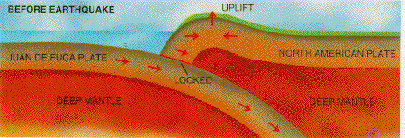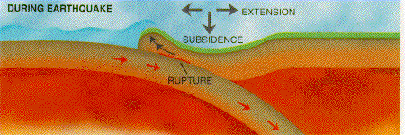West Coast Tectonics: The Cascadia Subduction Zone
The west coast of the NorthAmerica is renowned geologically for the San
Andreas fault that runs through the state of Califonia and in particularly
the San Francisco bay area. North of that area lies the Cascadia subduction
zone (CSZ), the most tectonically active zone in Canada. This zone extends
from Vancouver Island south to Northern California and is marked by the
west coast mountainn ranges like the Cascade and part of the Rocky mountain
range which were built up by the Farallon and Juan de Fuca plates being
subducted underneath the North American plate. The most famous rrecent evidence
of tectonic activity is the 1981 eruption of Mt.
St. Helens of which gave direct evidence that the plates were and still
are active in this region.
Most subduction zones usually show somewhat large and frequent seismic activity
but this is not the case for the CSZ region. The CSZ is for the most part
absent of tectonic activity and with recent records only going back 200
years there is no documentation of any large earthquakes to strike the area.
There are two possible theories that may explain why the area has not seen
much earthequake activity:
1) The Juan de Fuca plate and the remnant Farallon plate are quite lubricated
that there is a smooth constant slide underneath the North American plate,
thus there is no real significant stick-slip motion to create earthquakes.
2) The plates are locked and presently building up stress and strain because
there is no major movement between the plates, and no minor earthquakes
to indicate some movement.
Below is a cross section of the Cascadia Subduction Zone show ing the
movements of the North American and Pacific plates.

Here the plates are locked and building up stress.

The plates then give way releasing a huge amount of kinetic energy in
the form of shock waves or more commonly refered to as seismic waves. This
is what is known as an earthquake.

After the quake the basin that was created fills with sediment and the
stress again continued to build.
Scientific measurements show that thw Juan de Fuca plate is moving inland
at a rate of about 4mm per year (quite slow for a subduction zone). Over
a 500 year period that strain release would account for a 20 metre displacement
and over 900 years a 45 metere displacement. This translates to a tremendous
amount of locked potential energy that when released can cause a very large
scale quake in the order of maginitude of of about 8.5 to 9.5! So with these
measurments this evidence implies that indeed the plates are locked and
sometime in the near future the plates will give way resulting in a large
quake.
Using sedimentaty features and microfossils scientists are able to determine
how large and how frequent the large scale jolts occur.
Potential Risk.
Stratigraphy and how it is used.
Microfossils and how they are used.
How big and how long for the next one?
Back to the main menu.